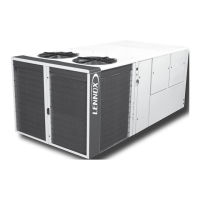Page 84 - IOM / ROOF-TOP FLEXY™ Series
PLANNED MAINTENANCE
Regular maintenance of your Rooftop will extend its operating
life and reduce operating faults. We recommend that the unit
is serviced by a trained refrigeration engineer.
A log book kept near the equipment detailing work carried
out, by whom and when, is an excellent diagnostic tool.
The panel opening key is required for this work (see
“TRANSPORT”).
MOTOR-FAN ASSEMBLY
After 50 operating hours check the belt tension and the pulley
screws for tightness. Repeat this check every two months.
The fans contain bearings that are "lubricated for life", but we
recommend replacing them every 10,000 operating hours.
During this inspection, check the condition of the anti-vibration
mounts, by looking for any cracks or signs of abnormal wear.
FILTERS
The filters fitted as standard are manufactured with a washable
and recyclable material. The CLIMATIC™ indicates if they are
blocked. The cleaning schedule is directly related to the
environment in which the equipment is operated. However,
monthly cleaning is recommended. A blocked filter will reduce
the performance and reliability of the Rooftop.
After removing the filters, remove any dust and wash them in
a tepid water solution with a little liquid detergent. After rinsing
in fresh water, leave the filters to dry. Take all necessary
precautions during operation to avoid damaging or piercing
the media, as this would require the damaged cell to be
replaced.
NOTE : The equipment must never be operated with the
filters removed.
To avoid prolonged shutdown, always keep a spare filter set.
HEAT EXCHANGERS
The performance of your equipment is directly linked to the
state of the heat exchangers, and it is therefore important to
ensure that they are cleaned regularly.
EVAPORATOR COIL (INTERNAL)
The exchange area must be kept clean at all times. It is
protected by the filters. If the filters are well maintained, the
coil will only require occasional general cleaning.
A brief inspection should be carried out when servicing the
filters.
CONDENSER COIL (EXTERNAL)
The condenser coil is not protected by the filters. The cleaning
schedule is directly related to the environment in which the
equipment is operated. A brief inspection should be carried
out when servicing the machine. Cleaning can be performed
using compressed air or a soft brush. Maximum caution is
needed as the aluminium fins are relatively fragile.
However, this type of cleaning is sometimes difficult and
relatively ineffective because the clogging is caused by a
mixture of grease vapour and powder. For this reason we
would recommend cleaning with PRESTOSOL, a de-greasing
agent with very low toxicity, non-flammable and which does
not corrode standard metals.
As a rule, it is sufficient to apply the product to the fins, moving
up and down and from left to right (as if you were painting it).
If the coil is very blocked, it may be necessary to wait a few
minutes after first applying the product and then continue.
This cleaning must be performed when the machine is
switched off. In addition, prior to restarting the machine, we
recommend waiting until the coil is fully drained and the solvent
has totally evaporated.
HOT WATER COIL
At the start of the heating season, check the following :
- There is sufficient water in the system
- The coil has been correctly drained
- The percentage of antifreeze proportion is sufficient for
the degree of protection required.
CONDENSATE TRAY AND DRAIN TRAP
The trag must be free of sediment and dirt which could block
the movement of condensation. Check that the siphon is not
obstructed. This inspection must be carried out at least once
a year, preferably at the start of the air-conditioning season.
GAS BURNER
Once a year, before the heating season, clean the burners
and the exchanger pipes using a nylon brush, the smoke box
and the extraction fan.
Check that the air inlet pipe to the safety thermostats is not
obstructed.
Check and adjust if necessary the min./max. pressure settings
on the controllers.
Check the position of the ionisation sensors and check the
ignition electrode.
To disassemble the burner, refer to the "GAS BURNER"
section.
ELECTRICAL TERMINALS
At least once a year :
- Power down the machine, blow away any dust from
inside the unit, and check and tighten if necessary the
connections.
- Power up the machine, test the safety mechanisms.
- An analysis of the terminal in operating mode can throw
light on any strange noises from the contactors or other
units. Foreign bodies can disrupt the operation of the
components and causes noisy vibration.
To avoid accidents, remember that this type of
maintenance requires electrical expertise.

